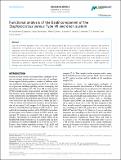Files in this item
Functional analysis of the EsaB component of the Staphylococcus aureus Type VII secretion system
Item metadata
| dc.contributor.author | Casabona, M Guillermina | |
| dc.contributor.author | Buchanan, Grant | |
| dc.contributor.author | Zoltner, Martin | |
| dc.contributor.author | Harkins, Catriona P | |
| dc.contributor.author | Holden, Matthew T G | |
| dc.contributor.author | Palmer, Tracy | |
| dc.date.accessioned | 2017-11-30T14:30:08Z | |
| dc.date.available | 2017-11-30T14:30:08Z | |
| dc.date.issued | 2017-12-01 | |
| dc.identifier | 251666302 | |
| dc.identifier | b89e3004-b1f7-43fc-81ca-6d8340174127 | |
| dc.identifier | 29165232 | |
| dc.identifier | 85044291898 | |
| dc.identifier | 000423293700012 | |
| dc.identifier.citation | Casabona , M G , Buchanan , G , Zoltner , M , Harkins , C P , Holden , M T G & Palmer , T 2017 , ' Functional analysis of the EsaB component of the Staphylococcus aureus Type VII secretion system ' , Microbiology , vol. 163 , no. 12 , pp. 1851-1863 . https://doi.org/10.1099/mic.0.000580 | en |
| dc.identifier.issn | 1350-0872 | |
| dc.identifier.other | ORCID: /0000-0002-4958-2166/work/60196367 | |
| dc.identifier.uri | https://hdl.handle.net/10023/12209 | |
| dc.description | This study was supported by the Wellcome Trust (through Investigator Award 10183/Z/15/Z to TP and through Clinical PhD studentship support to CPH through grant 104241/z/14/z), the Biotechnology and Biological Sciences Research Council and the Medical Research Council (through grants BB/H007571/1 and MR/M011224/1, respectively). | en |
| dc.description.abstract | Type VII secretion systems (T7SS) are found in many bacteria and secrete proteins involved in virulence and bacterial competition. In Staphylococcus aureus the small ubiquitin-like EsaB protein has been previously implicated as having a regulatory role in the production of the EsxC substrate. Here we show that in the S. aureus RN6390 strain, EsaB does not genetically regulate production of any T7 substrates or components, but is indispensable for secretion activity. Consistent with EsaB being an essential component of the T7SS, loss of either EsaB or EssC are associated with upregulation of a common set of iron acquisition genes. However, a further subset of genes were dysregulated only in the absence of EsaB. Quantitative western blotting indicates that EsaB is present at very low levels in cells. Substitution of a highly conserved threonine for alanine or arginine resulted in a loss of EsaB activity and destabilisation of the protein. Taken together our findings show that EsaB is essential for T7SS activity in RN6390. | |
| dc.format.extent | 13 | |
| dc.format.extent | 2194672 | |
| dc.language.iso | eng | |
| dc.relation.ispartof | Microbiology | en |
| dc.subject | Protein secretion | en |
| dc.subject | T7SS | en |
| dc.subject | Regulation | en |
| dc.subject | Staphylococcus aureus | en |
| dc.subject | QH301 Biology | en |
| dc.subject | QR Microbiology | en |
| dc.subject | NDAS | en |
| dc.subject.lcc | QH301 | en |
| dc.subject.lcc | QR | en |
| dc.title | Functional analysis of the EsaB component of the Staphylococcus aureus Type VII secretion system | en |
| dc.type | Journal article | en |
| dc.contributor.institution | University of St Andrews. School of Medicine | en |
| dc.contributor.institution | University of St Andrews. Infection Group | en |
| dc.contributor.institution | University of St Andrews. Infection and Global Health Division | en |
| dc.contributor.institution | University of St Andrews. Biomedical Sciences Research Complex | en |
| dc.identifier.doi | 10.1099/mic.0.000580 | |
| dc.description.status | Peer reviewed | en |
This item appears in the following Collection(s)
Items in the St Andrews Research Repository are protected by copyright, with all rights reserved, unless otherwise indicated.

